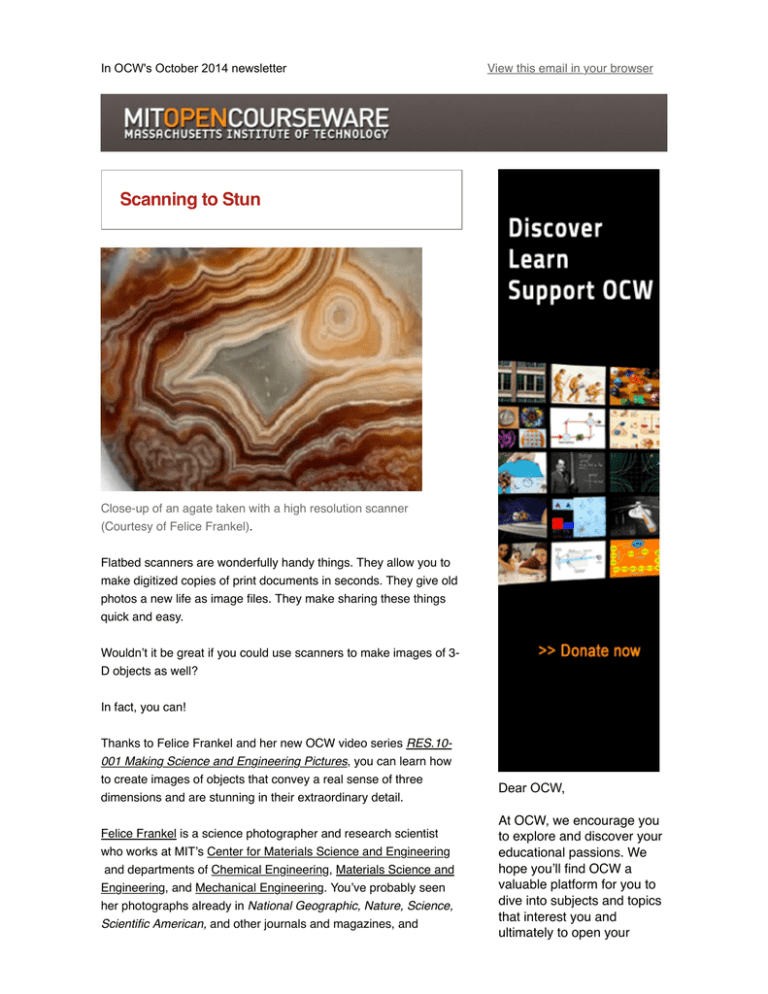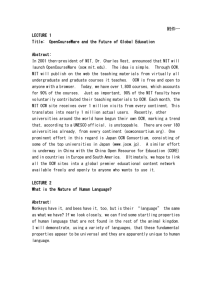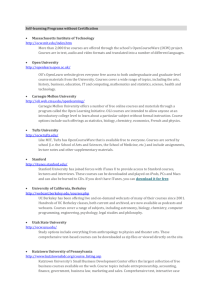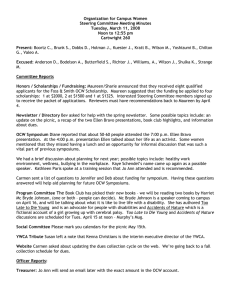Scanning to Stun
advertisement

In OCW's October 2014 newsletter View this email in your browser Scanning to Stun Close-up of an agate taken with a high resolution scanner (Courtesy of Felice Frankel). Flatbed scanners are wonderfully handy things. They allow you to make digitized copies of print documents in seconds. They give old photos a new life as image files. They make sharing these things quick and easy. Wouldn’t it be great if you could use scanners to make images of 3D objects as well? In fact, you can! Thanks to Felice Frankel and her new OCW video series RES.10001 Making Science and Engineering Pictures, you can learn how to create images of objects that convey a real sense of three dimensions and are stunning in their extraordinary detail. Felice Frankel is a science photographer and research scientist who works at MIT’s Center for Materials Science and Engineering and departments of Chemical Engineering, Materials Science and Engineering, and Mechanical Engineering. You’ve probably seen her photographs already in National Geographic, Nature, Science, Scientific American, and other journals and magazines, and Dear OCW, At OCW, we encourage you to explore and discover your educational passions. We hope you’ll find OCW a valuable platform for you to dive into subjects and topics that interest you and ultimately to open your perhaps in the books she has published. horizons. Felice wants everyone to share in her understanding of how to use a high-resolution flatbed scanner to make finely detailed images— so finely detailed they rival the photographs she takes with an expensive camera. But we need your help to continue to serve as a key resource. In a series of four demonstration videos, followed by two how-to videos, Felice shows the tricks of this not-so-well-known trade. A flatbed scanner has a single unadjustable light source that moves across the scanning plane in a single direction, so there’s no fussing with lighting to vary effects. The image-maker must use other methods to create engaging images. What methods? Varying the position of the object, applying different backgrounds, directing the light from below or from above, even If you haven't already and can afford to do so, please consider donating to OCW during our fall campaign. Your donation, large or small, makes a difference. If you have already donated, we thank you for being a member of our community of supporters. leaving the scanner cover open—all these things can produce very different artistic effects. Using these methods, Felice shows how she has created highresolution images of petri dishes, solar cells, microfluidic displays, watch gears, an agate, even a raw egg—images that can then be zoomed in on to show details at the level of 30 to 50 microns. The videos in this OCW series are part of a more extensive online course in image-making that Felice plans to produce for MITx in 2015. But why not get a head start now with RES.10-001! New Courses OCW is grateful for the support of: STS.004 Science, CMS.611J Creating Video Technology, & World Games 5.61 Physical Chemistry 7.347 Epigenetic Regulation of Stem Cells Updated Courses 8.05 Quantum Physics II 9.20 Animal Behavior 2.14 Analysis and Design of feedback Control Systems > Find courses that interest you > Subscribe to the RSS OCW Educator Lecturer Blade Kotelly leads a class discussion about the 10-step design process and toothbrushes. A well-planned birthday party and your new smartphone might not seem to have much in common. But they’re both examples of how successful design thinking leads to good results. Making such connections with everyday objects and experiences is a foundation of the course ESD.051J Engineering Innovation and Design, just published in OCW. Students learn to produce great designs, be more effective engineers, and communicate with high emotional and intellectual impact. The course is taught by lecturer Blade Kotelly and Prof. Joel Schindall. The OCW site includes includes five “instructor insights” videos on the This Course at MIT page, such as this one on Teaching Design Thinking. What really happens in class? You can see for yourself with two sample lecture videos, which highlight the high-energy Socratic style of instruction and classroom discussion. As one of the core requirements in the Gordon-MIT Engineering Leadership program, this course attracts students who are keenly interested to make an impact in the world. For instance, as reported by MIT Admissions blogger Maggie L. ’12, two students parlayed what they learned from their class projects on speech systems into an award-winning submission for GM’s OnStar Student Developer Challenge. With this course, you’ll get a new appreciation for the well-designed things and experiences you come across everyday…and probably some great ideas for how to make them even better! Highlights for High School Reverse engineer, break, hack, decrypt, or do whatever it takes to solve the challenge. When your father disappears under strange circumstances, a flash drive is your only clue to his whereabouts. You will need to use all of the computer security skills at your disposal to uncover and decipher critical evidence. Can you solve the mystery before it's too late? This is the challenge for this year's picoCTF competition. It's a game of a series of challenges where you must reverse engineer, break, hack, decrypt, or do whatever it takes to solve the challenge. The challenges are all set up with the intent of being hacked, making it an excellent, legal way to get hands-on experience. To prepare yourself for the competition, brush up on your computer hacking skills with OCW's materials on java, C, and python (though you don't need to be an expert on these computer languages). > Visit computer engineering courses on Highlights for High School MITx News Image of Newton's cradle which demonstrates conservation of momentum and energy. Image by edtechie99. Transitioning to College via a MOOC Coming soon to MITx on edX is a new kind of MOOC—a MOOC to help high school students better prepare for college. Many students who arrive at college find themselves struggling with the courses they must take, as their high school experience has not provided them with the necessary preparation to do well at college. Most current MOOC offerings already reflect the rigor of college instruction, and less well-prepared students struggle to take advantage of these exciting new learning experiences. Instead of jumping forward, they are frustrated from the start. edX has taken steps to remedy this situation by creating the edX High School Initiative. Its goal is to address the student “readiness gap” and make MOOC learning at the college level easier for those in need of additional preparation. The hope is to “provide a path to life-long continuous education,” edX CEO Anant Agarwal said recently when announcing the Initiative. edX will start off with 27 new online courses, including Advanced Placement® (AP®)* courses and other high school courses in a wide variety of subject areas. Among the first offerings is 8.MechCx AP Physics C: Mechanics, which starts on January 8, 2015 and runs for 13 weeks. This is a college-level Introductory Newtonian Mechanics course that covers the topics and learning objectives specified in the syllabus of the College Board for an AP Physics, Mechanics C course. Emphasizing that all mechanics is about how forces change motion, the course covers Kinematics in Two Dimensions, Newton’s Laws, Mechanical Energy, Momentum, Rigid Body Rotation and Dynamics, and Angular Momentum. The goal is to help students learn and practice how experts in physics solve problems that are similar to problems on previous AP Examinations in Mechanics C. The lead instructor for this course is MIT Professor David Pritchard, a pioneering atomic physicist who has applied his research abilities to the field of online learning for many years. He leads an education research group, Research in Learning, Assessing, and Tutoring Effectively. 8.MechCx is the fifth MOOC that this group has authored and run. Students interested in taking 8.MechCx can give themselves a head start by checking out OCW’s Highlights for High School, our collection of open educational resources for high school students and teachers. The collection includes resources that are mapped to topics in the AP science curriculum, including physics. * Advanced Placement and AP are registered trademarks of the College Board. Views From Our Supporters "MIT-OCW is an amazing resource for continued selfeducation and I hope my donation is used to improve it further." - Juhwan, Independent Learner, USA > Read more Tell us what you think of OCW here. Facebook Twitter unsubscribe from this list Email Google Plus LinkedIn update subscription preferences


